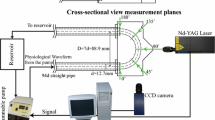Abstract
Study of swirling flows in channels corresponding to the static approximation of flow channels of the heart and major vessels with a longitudinal–radial profile zR2 = const and a concave streamlined surface at the beginning of the longitudinal coordinate has been carried out. A comparative analysis of the flow structure in channel configurations zRN = const, where N = –1, 1, 2, 3, in the absence and presence of a concave surface was carried out. The numerical modeling was compared with the results of hydrodynamic experiments on the flow characteristics and the shape of the flow lines. The numerical model was used to determine the velocity structure, viscous friction losses, and shear stresses. Numerical modeling of steady-state flows for channels without a concave surface showed that in the channel zR2 = const there is a stable vortex flow structure with the lowest viscous friction losses. The presence of a concave surface of sufficient size significantly reduces viscous friction losses and shear stresses in both the steady state and pulsed modes.

















Similar content being viewed by others
REFERENCES
Frazin, L.J. et al., Confirmation and initial documentation of thoracic and abdominal aortic helical flow. An ultrasound study, ASAIO J., 1992, vol. 42, no. 6, pp. 951–956.
Gorodkov, A., Dobrova, N.B., Kuzmina, N.B., et al., Anatomical structures determining blood flow in the heart left ventricle, J. Mater. Sci.: Mater. Med., 1996, vol. 7, no. 3, pp. 153–160. https://doi.org/10.1007/BF00121254
Zhorzholiani, S.T., Mironov, A.A., Talygin, E.A., et al., Analysis of dynamic geometric configuration of the aortic channel from the perspective of tornado-like flow organization of blood flow, Bull. Exp. Biol. Med., 2018, vol. 164, pp. 514–518. https://doi.org/10.1007/s10517-018-4023-z
Kiknadze, G.I., Oleinikov, V.G., Gachechiladze, I.A., Gorodkov, A.Y., Dobrova, N.B., Baquey, C., and Barat, J.L., Analysis of flow structure in the aorta and left ventricle of the heart using exact solutions of non-stationary hydrodynamic equations and morphometric studies, Dokl. Biochem. Biophys., 1996, vol. 349, pp. 59–62.
Bockeria, L.A., Gorodkov, A.Y., Kiknadze, G.I., and Gachechiladze, I.A., Application of Tornado-flow fundamental hydrodynamic theory to the study of blood flow in the heart, Further development of tornado-like jet technology, ASME 2011 International Mechanical Engineering Congress and Exposition, IMECE 2011, Denver, CO, 2011, vol. 2, pp. 287–296. https://doi.org/10.1115/imece2011-63769
Talygin, E.A., Zazybo, N.A., Zhorzholiany, S.T., Krestinich, I.M., Mironov, A.A., Kiknadze, G.I., Bokerya, L.A., Gorodkov, A.Y., Makarenko, V.N., and Alexandrova, S.A., Quantitative evaluation of intracardiac blood flow by left ventricle dynamic anatovy based on exact solutions of non-stationary Navier–Stocks equations for self-organized tornado-like flows of viscous incompresssible fluid, Usp. Fiziol. Nauk, 2016, vol. 47, no. 1, pp. 48–68. PMID: .27149823
Zhorzholiani, S.T., Talygin, E.A., Krasheninnikov, S.V., et al., Elasticity change along the aorta is a mechanism for supporting the physiological self-organization of tornado-like blood flow, Hum. Physiol., 2018, vol. 44, no. 5, pp. 532–540. https://doi.org/10.1134/S0362119718050171
Kiknadze, G.I. and Krasnov, Yu.K., Evolution of spout-like flows of a viscous fluid, Sov. Phys. Dokl., 1986, vol. 31, no. 10, pp. 799–801.
Burgers, J.M., A mathematical model illustrating the theory of turbulence, Adv. Appl. Mech., 1948, no. 1, pp. 171–179.
Kiknadze, G.I., Talygin, E.A., and Gorodkov, A.Yu., Method of suction of boundary layer of continuous medium from the surface of a body and a device for its realization, RF Patent no. 2691705 C1, 2019.
Piralishvili, S.A. and Pisarevskii, A.S., Numerical simulation of vortex effect in an incompressible fluid, Fluid Dyn., 2013, vol. 48, no. 3, pp. 407–415.
Gaifullin, A.M. and Zhvick, V.V., Interaction between two oppositely swirled submerged jets, Fluid Dyn., 2019, vol. 54, no. 3, pp. 339–348. https://doi.org/10.1134/S001546281902006X
Platonov, D.V., Minakov, A.A.V., Dekterev, A.A., and Sentyabov, A.V., Numerical modelling of spatial flows with flow twist, Comput. Res. Model., 2013, vol. 5, no. 4, pp. 635–648.
Vysotina, V.G., Structure of the swirling flow in axisymmetric channels, Matem. Model., 2003, vol. 15, no. 1, pp. 69–77.
Shipkowitz, T. et al., Numerical study on the effect of steady axial flow development in the human aorta on local shear stresses in abdominal aortic branches, J. Biomech., 1998, vol. 31, no. 11, pp. 995–1007.
Wilcox, D.C., Formulation of the kw turbulence model revisited, AIAA J., 2008, vol. 46, no. 11, pp. 2823–2838.
Versteeg, H.K. and Malalasekera, W., An Introduction to Computational Fluid Dynamics: The Finite Volume Method, Pearson Education, 2007.
Mitrofanova, O.V., Hydrodynamics and heat exchange of swirling flows in channels with swirlers, Teplofiz. Vys. Temp., 2003, vol. 41, no. 4, pp. 587–633.
Brown, C.H., et al., Morphological, biochemical, and functional changes in human platelets subjected to shear stress, J. Lab. Clin. Med., 1975, vol. 86, no. 3, pp. 462–471.
Sutera, S.P., Flow-induced trauma to blood cells, Circ. Res., 1977, vol. 41, no. 1, pp. 2–8.
Funding
This study was supported by the Russian Science Foundation, grant no. 22-15-00148.
Author information
Authors and Affiliations
Corresponding author
Ethics declarations
CONFLICT OF INTEREST
The authors of this work declare that they have no conflicts of interest.
ETHICS APPROVAL AND CONSENT TO PARTICIPATE
Animal experiments were conducted in accordance with the National Institutes of Health Guide for the Care and Use of Laboratory Animals (http://oacu.od.nih.gov/ regs/index.htm). Protocols for animal experiments were approved by the Commission on Biological Safety and Bioethics of the Institute of Theoretical and Experimental Biophysics, Russian Academy of Sciences (no. 11/2023 dated August 2, 2023).
This study was approved by the local ethics committee of the Bakulev National Medical Research Center for Cardiovascular Surgery of the Ministry of Health of the Russian Federation.
Additional information
Publisher’s Note.
Pleiades Publishing remains neutral with regard to jurisdictional claims in published maps and institutional affiliations.
Rights and permissions
About this article
Cite this article
Zharkov, Y.E., Zhorzholiani, S.T., Sergeev, A.A. et al. Experimental and Model Study of a Swirling Fluid Flow in a Converging Channel As a Simulation of Blood Flow in the Heart and Aorta. Dokl Biochem Biophys 513 (Suppl 1), S36–S52 (2023). https://doi.org/10.1134/S1607672924700777
Received:
Revised:
Accepted:
Published:
Issue Date:
DOI: https://doi.org/10.1134/S1607672924700777



